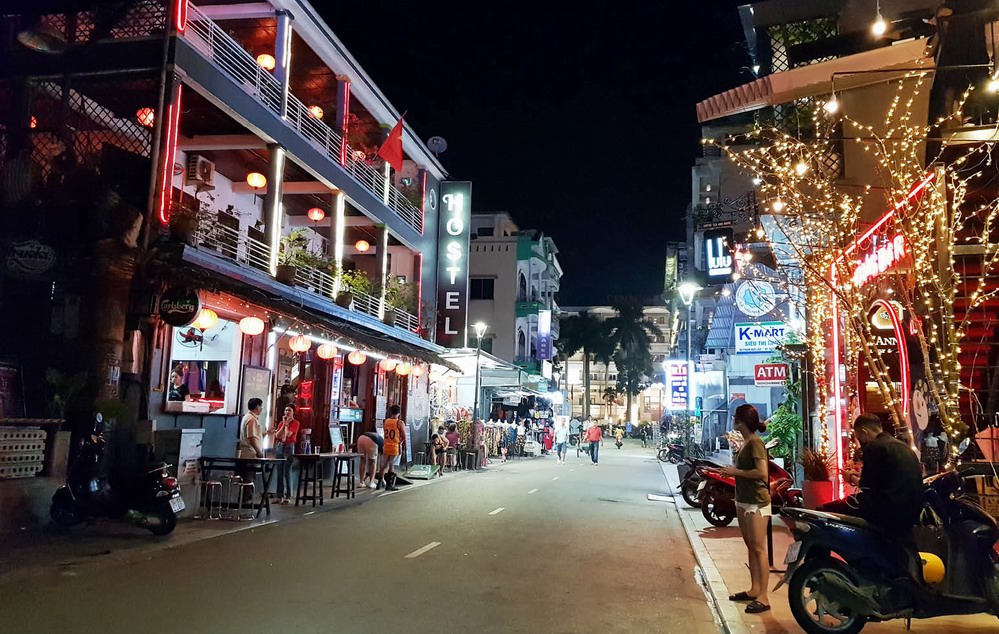|
Explore backpackers street in Hue

Unlike the bustling backpackers areas in other tourist cities in Vietnam, the
backpackers streets in Hue still retain the inherent tranquility of the ancient
capital city.
Busy at night
Along the street are souvenir shops selling all kinds of traditional goods,
restaurants, hotels and tourist offices. The street is most bustling when night
falls. Groups of tourists stroll around the souvenir shops, after a day of
visiting the royal palace, mausoleums or temples.
The main street of the backpackers area in Hue coincidentally also has the name
Pham Ngu Lao, similar to the backpackers street in Ho Chi Minh City.
Today, this area has expanded to nearby streets such as Chu Van An, Le Loi, Vo
Thi Sau. There is a restaurant named DMZ (the demilitarized zone during the
war), located right at the corner of Le Loi - Pham Ngu Lao, with tables and
chairs placed outdoors.
On Pham Ngu Lao street, there are some large restaurants that also sell coffee,
such as Octopus. The restaurant is painted in elegant pink, an old-fashioned
house, formerly a garden house. The restaurant's name is stylized as an octopus,
inlaid with broken pieces of porcelain, which looks quite beautiful. Along Pham
Ngu Lao street, of course, there are also restaurants serving Hue specialties
such as beef noodle soup, Banh Beo, Banh Khoai, Banh Nam, and Nem Lui.
The names of the dishes are written in both Vietnamese and English: Bun Bo is
Hue beef noodle soup; Banh Nam is Nam pancake… This translation is quite naive,
so it may be difficult for foreign tourists to imagine what the dish is.
Therefore, some restaurants have printed pictures of the dishes on the menu,
under the English names to make it easier to imagine.
The old days were deserted
In the backpackers street, there are also some very striking cyclos: The frame
is painted Hue purple and the canvas is red to protect from the sun and rain.
In the 1980s, only student couples strolled here. It was deserted because this
road was short and few people lived there, there were very large garden houses.
This place began to have more buildings, after the appearance of the Hoa Hong
Hotel and other tourism services. Then other shops, hotels… also appeared. From
then on, the land price began to increase.
Pham Ngu Lao street is just over 200m long, with Vo Thi Sau and Le Loi streets
at both ends. Le Loi Street has the most beautiful location and the most
expensive houses in the ancient capital city, located along the banks of the
Perfume River with nearly 60 ancient trees. The ancient city still preserves
many relics recognized by UNESCO as world cultural heritage, including Bach Ma
Mountain - where the French previously built a resort, and many beautiful
pagodas such as Thien Mu.
Hue is near Quang Binh – famous for Phong Nha cave, Quang Tri ancient citadel,
Vinh Moc tunnel, Hien Luong bridge… This city is also not far from Hoi An so it
can be considered a tourist center, visitors can stop by before visiting other
tourist attractions.
It is special that right in the middle of the backpackers street is the home of
a Hue singing group, at the house of writer Buu Y (9 Pham Ngu Lao). The group
usually meets every Saturday. Veteran Hue singing artists such as Thanh Tam,
Minh Man, Thanh Huong… still come here to sing for audiences.
The place also welcomes many domestic and foreign tourist groups to enjoy and
learn about Hue folk singing, you do not need to buy tickets as it is not to do
business.
The artisans just want to preserve and introduce this art form. No matter how
much the backpackers area in particular and Hue City in general develop, it
seems that some locals still try to preserve the unique traditional cultural
features, not wanting them to be lost.
Ethnic Travel Vietnam has
positioned itself as the leading travel brand in Indochina in terms of service
quality, particularly in the Vietnam market.
|
|